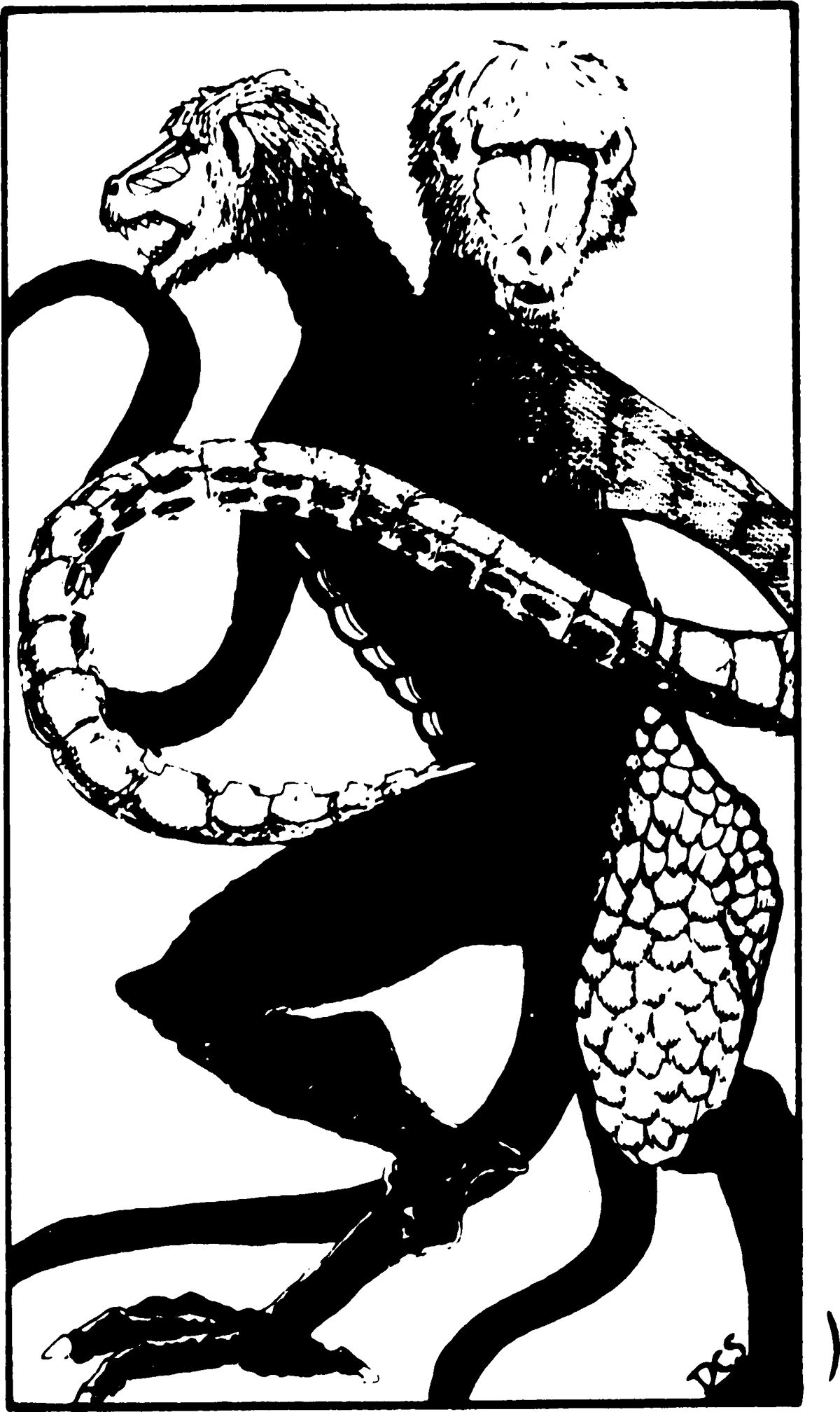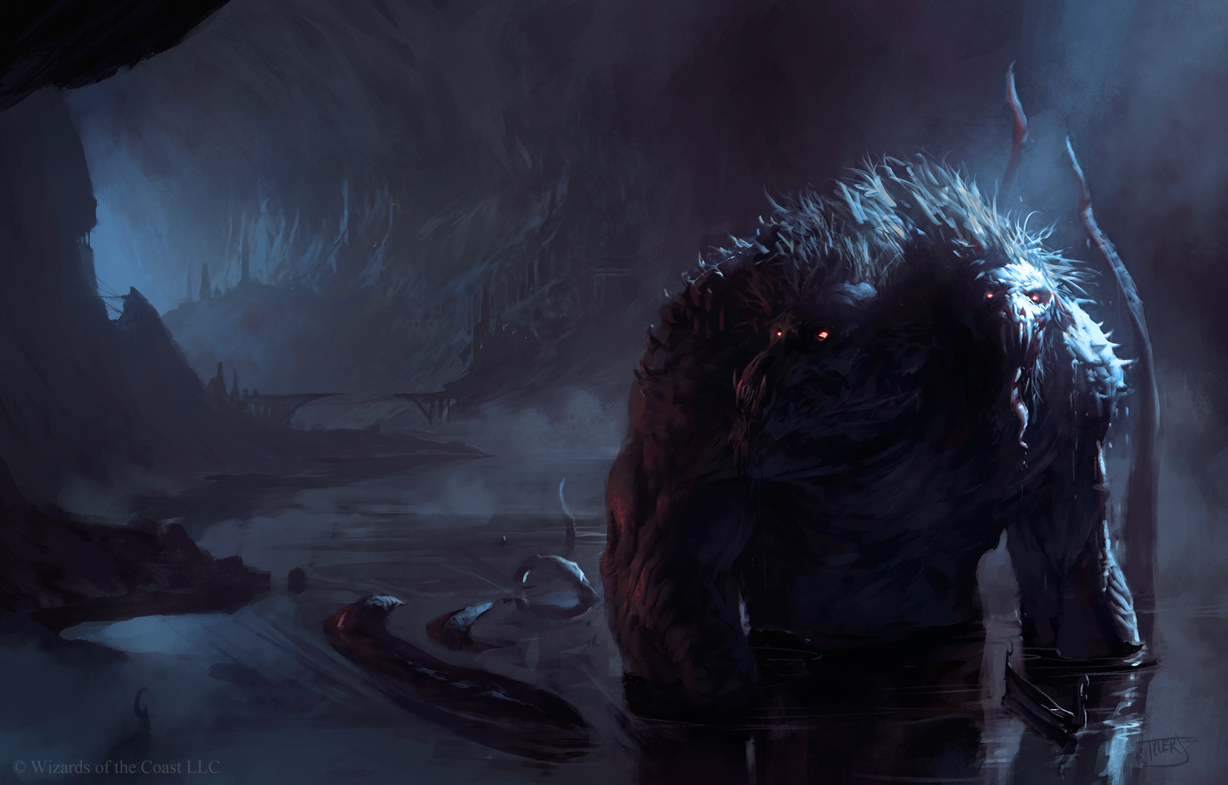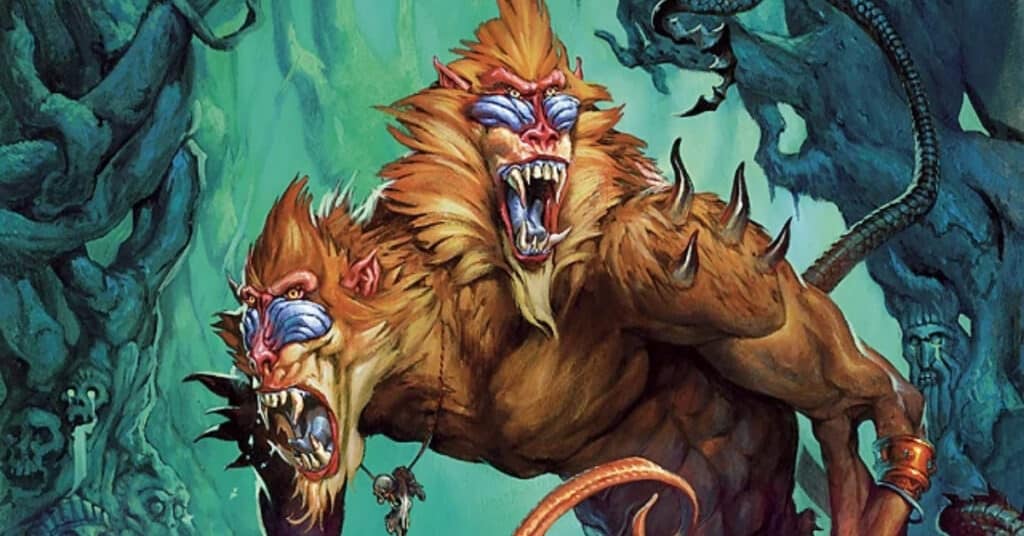Last Updated on January 22, 2023
Prince of Demons, the Sibilant Beast, and Master of the Spiraling Depths — there are many names for the great two-headed thing that dwells below.
There are many who worship him, seeking power and finding only madness and delirium. There are many more who fear him and dare only speak his name in whispers: Demogorgon.
Welcome to our guide to one of Dungeons & Dragons’ most terrifying foes, an iconic bad guy who ranks among the deadliest entities in the multiverse.
So buckle up. Today, we’re going to be giving you the rundown on the BBEG who could eat Strahd, Vecna, and maybe even Tiamat for breakfast as we ask…
Who Is Demogorgon in DnD 5e?
Demogorgon is one of the most powerful demons in the D&D multiverse. Clawed, webbed feet and scaly saurian legs lead up to the torso of a great ape with writhing tentacles for arms.
Perched atop this monstrosity are twin baboon heads named Aameul and Hathradiah, their eyes lit from within by smoldering hellfire.
To lay eyes upon the Demogorgon is to behold a chimeric, cosmic horror.
His form is so nightmarish that even looking at depictions of him is enough to provoke fits of madness, and those who worship him as a god all sooner or later divorce from reality on the road to irreparable mental collapse.
Demogorgon is an entity of pure and unbridled chaos. His very presence unbinds the fabric of reality, warping and bending physical laws into foul perversions of the natural order.
His hatred of life is also all-consuming, and his ultimate goal is to wipe out all other life in the universe. Terrifyingly, it’s an ambition that Demogorgon is almost certainly powerful enough to achieve.
The only reason his plan to annihilate all of creation inside a roiling vortex of entropy and carnage hasn’t already worked is that his attention is split.
His (self-proclaimed) title “Prince of Demons” puts him in direct competition with other, ultra-powerful demon lords, especially Orcus, the Demon Prince of Undeath.
The two demons are locked in a more-or-less constant blood feud and devote a great deal of their energies and followers to fighting ceaseless, brutal proxy wars.
Still, Demogorgon is probably powerful enough to wipe out Orcus. However, each of the demon lord’s two heads — Aameul and Hathradiah — hate one another almost as much as they hate everything else, and their constant bickering, not to mention attempts to assassinate each other (thereby taking full control of their shared body), often undermine Demogorgon’s loftier schemes.
Origins of Demogorgon
Demogorgon — like many other monsters in D&D — is drawn from Greek mythology. More accurately, the name Demogorgon is thought to have come from a Dark Ages mistranslation of Greek mythology.
A monk, sometime in the 4th century, probably misread the phrase demiurge (meaning one of the figures in a Neoplatonic school of philosophy responsible for crafting the universe) and came up with Demogorgon.
A blending of demon and gorgon — a combination that basically means “dire or terrifying spirit” — Demogorgon went through several reinterpretations during the middle ages from child of the Roman god Jupiter, to a powerful spirit, and finally to a demon in the classical Christian sense sometime in the late Medieval period.
Since then, Demogorgon has been named in works that include Milton’s Paradise Lost, Doctor Faustus, and a weird short story by Voltaire called “Plato’s Dream” in which he’s responsible for creating the Earth.
Obviously, it’s his later incarnation as a D&D villain that’s behind his appearance in Stranger Things.
Demogorgon first appeared in Dungeons & Dragon’s 1st edition back in 1976 as part of the game’s third supplement, Eldritch Wizardry (also the supplement that introduced Orcus, the mind flayer, and the Hand and Eye of Vecna).
Since then, he has been a reoccurring foe throughout every edition of D&D with his notable appearances including the super high-level AD&D adventure Throne of Bloodstone and the 5e Underdark campaign Out of the Abyss.

Where Does Demogorgon Live?
Demogorgon hails from the 88th layer of the Abyss, known as the Gaping Maw. Here, he dwells in a vast, briny sea punctured with giant spikes of dark stone.
This cyclopean landscape is also inhabited by aboleths and other strange, warped creatures of the deep.
Here, he roams in waist-high water, striding to and fro from his twin tower topped by giant skulls called Abysm, which focuses his dread spellcasting abilities.
Wherever Demogorgon spends any amount of time, however, his very presence starts to have a noticeable effect on the surrounding region.
Demogorgon Regional Effects
The region containing Demogorgon’s lair is touched by his magic, warping reality and producing the following effects…
- Beguiling Realm: Within 6 miles of the lair, all Charisma (Persuasion) and Charisma (Performance) checks have disadvantage, and all Charisma (Deception) and Charisma (Intimidation) checks have advantage.
- Frenzied Animals: Beasts within 1 mile of the lair become frenzied and violent — normally docile creatures. Within that area, any ability check involving Animal Handling has disadvantage.
- Venomous Beasts: The area within 6 miles of the lair becomes overpopulated with poisonous snakes and other venomous Beasts.
If Demogorgon dies, these effects fade over the course of 1d10 days.
Fighting Demogorgon

In 5e, Demogorgon gets the benefits of a stat block both in Out of the Abyss, although you’re definitely not meant to fight him in that adventure; your 3rd-level characters are supposed to sit back and enjoy the show as he rampages out of a lake and eats a whole village of Kuo Toa.
He has recently been reworked as part of the new Mordenkainen Presents: Monsters of the Multiverse sourcebook, which streamlines some of his abilities and actually makes him less of a melee-range brute than you’d expect.
Still, even though he’s a more subtle enemy than you’d expect with a challenge rating of 26, fighting Demogorgon head on is the kind of thing that only very powerful (and/or very stupid) parties of adventurers choose to do.
Let’s take a look at what this demon lord brings to the initiative order.
Demogorgon
Huge Fiend (Demon), Chaotic Evil
- AC: 22 (natural armor)
- Hit Points: 464 (32d12 + 256)
- Speed: 50 ft., swim 50 ft.
- STR 29 (+9), DEX 14 (+2), CON 26 (+8), INT 20 (+5), WIS 17 (+3), CHA 25 (+7)
- Saving Throws: Dex +10, Con +16, Wis +11, Cha +15
- Skills: Insight +11, Perception +19
- Damage Resistances: Cold, fire, lightning
- Damage Immunities: Poison; bludgeoning, piercing, and slashing that is nonmagical
- Condition Immunities: Charmed, exhaustion, frightened, poisoned
- Senses: Truesight 120 ft., Passive Perception 29
- Languages: All, telepathy 120 ft.
- Challenge: 26 (90000 XP)
- Proficiency Bonus: +8
Legendary Resistance (3/Day). If Demogorgon fails a saving throw, he can choose to succeed instead.
Magic Resistance. Demogorgon has advantage on saving throws against spells and other magical effects.
Two Heads. Demogorgon has advantage on saving throws against being blinded, deafened, stunned, or knocked unconscious.
ACTIONS
Multiattack. Demogorgon makes two Tentacle attacks. He can replace one attack with the use of Gaze.
Tentacle. Melee Weapon Attack: +17 to hit, reach 10 ft., one target. Hit: 28 (3d12 + 9) force damage.
If the target is a creature, it must succeed on a DC 23 Constitution saving throw, or its hit point maximum is reduced by an amount equal to the damage taken.
This reduction lasts until the target finishes a long rest. The target dies if its hit point maximum is reduced to 0.
Gaze. Demogorgon turns his magical gaze toward one creature he can see within 120 feet of him. The target must succeed on a DC 23 Wisdom Saving throw or suffer one of the following effects (choose one or roll a d6):
1-2: Beguiling Gaze. The target is stunned until the start of Demogorgon’s next turn or until Demogorgon is no longer within line of sight.
3-4: Confusing Gaze. The target suffers the effect of the confusion spell without making a saving throw. The effect lasts until the start of Demogorgon’s next turn. Demogorgon doesn’t need to concentrate on the spell.
5-6: Hypnotic Gaze. The target is charmed by Demogorgon until the start of Demogorgon’s next turn. Demogorgon chooses how the charmed target uses its action, reaction, and movement.
Spellcasting. Demogorgon casts one of the following spells, requiring no material components and using Charisma as the spellcasting ability (Spell Save DC 23):
At will: Detect magic, major image
3/day each: Dispel magic, fear, telekinesis
1/day each: Feeblemind, project image
LEGENDARY ACTIONS
Demogorgon can take two legendary actions, choosing from the options below. Only one legendary action option can be used at a time and only at the end of another creature’s turn.
Demogorgon regains spent legendary actions at the start of his turn.
Gaze. Demogorgon uses Gaze and must use either Beguiling Gaze or Confusing Gaze.
Tail. Melee Weapon Attack: +17 to hit, reach 15 ft., one target. Hit: 20 (2d10 + 9) bludgeoning damage plus 11 (2d10) necrotic damage.
Cast a Spell (Costs 2 Actions). Demogorgon uses Spellcasting.
So, with the exception of an eye-wateringly big pool of hit points, Demogorgon isn’t actually all that terrifying at first glance.
He doesn’t have a big AoE attack like an ancient dragon or greatwyrm. He doesn’t know a whole bunch of instant-suck spells like a lich with Power Word Kill.
He only makes two attacks per round. Admittedly, the max hit point reduction is pretty scary, but it’s the kind of thing that spells like Greater Restoration were made for.
Even mid-tier monsters have “claw-claw-bite”; Demogorgon just has “slap-slap-???”
However, once you dig a little deeper into the implications of this stat block, you start to see that this gigantic, screaming, tentacled baboon-dinosaur hybrid is actually a remarkably subtle, sophisticated combatant.
Pretty much everything in the Demogorgon’s toolkit is designed to either disable his enemies or turn their strengths against them.
Look at options like feeblemind (which, once per day, can reduce a creature’s Intelligence and Charisma scores to 1), dispel magic, fear, Beguiling Gaze, and Confusing Gaze (these last two have a truly brutal saving throw and virtually ensure that their target won’t be doing whatever it is they’re planning to do until next round).
They can all take an enemy out of play if used correctly.
Then there’s the really dangerous stuff. Hypnotic Gaze will probably put a 20th-level character under the Demogorgon’s spell for a whole turn.
That’s plenty of time for a fighter to kill the party wizard with five sustained attacks or the wizard to gun down the fighter permanently with disintegrate.
Even without the inevitable tide of minions and cultists flocking to protect him, Demogorgon is a shockingly slippery foe and way more interesting to run as a dungeon master than a lot of super high-CR creatures.

Cults and Avatars of Demogorgon: A More Usable Monster
There’s a really great blog post by Joseph Manola of Against the Wicked City, called “Your Demon Lord Doesn’t Need That Many Hit Dice.”
In the piece, Manola first points out that, while player characters have undeniably seen their power levels and hit-point pools bloat over the past four editions of the game, “They haven’t been the biggest winners. The biggest winners have been the high-level monsters.”
His point, in essence, is that high-level monsters in D&D 5e are so dramatically inflated in terms of power that they aren’t actually very useful or interesting as gameable content.
To take Demogorgon as an example of this, back in the 1st edition Monster Manual, Demogorgon was the biggest and most dangerous entry by a significant margin with… a grand total of 200 hit points.
For context, the arch-devil Asmodeus had just 199, Orcus a measly 120, and you could kill yourself a Balor in 1e D&D if you could dish out 100 hit points of damage.
Doesn’t that seem more … attainable than 5e Demogorgon, a near-godlike entity who averages 464 hit points? He’s not even the biggest thing out there anymore. The Tarrasque has more than 200 hp more than Demogorgon.
It all makes me think that — unless you’re playing an ultra high-level game, which very few people are — the only goal of these monsters is rampaging background cutscenes.
They’re the D&D version of a J.J. Abrams skybeam.
Something that gives the heroes something pretty to look at as they try to derail a ritual, perform a ritual, or put the right MacGuffin into the right slot on the giant MacGuffin-powered machine that will stop the great big monster in the background.
And that’s… fine. But it feels like a waste.
I think that a bunch of 20th-level heroes chewing through 400+ hit points worth of demon lord would probably be pretty boring. However, that’s more of a systemic issue with high-level play than it is with Demogorgon himself.
Demogorgon is a really interesting monster, and I want to give my players a chance to fight him without them all being 20th level.
Therefore, allow me to introduce the Avatar of Demogorgon, a lower-CR monster that could be summoned by an evil wizard and thrown at a party of adventurers as low as 5th level.
Avatar of Demogorgon
Large Fiend (Demon), Chaotic Evil
- AC: 14 (natural armor)
- Hit Points: 80
- Speed: 50 ft., swim 50 ft.
- STR 19 (+4), DEX 14 (+2), CON 20 (+5), INT 18 (+4), WIS 13 (+1), CHA 14 (+2)
- Damage Resistances: Fire, bludgeoning, piercing, and slashing that is nonmagical
- Damage Immunities: Poison
- Condition Immunities: Charmed, exhaustion, frightened, poisoned
- Senses: Darkvision 120 ft., Passive Perception 14
- Languages: All, telepathy 60 ft.
- Proficiency Bonus: +4
Magic Resistance. Demogorgon has advantage on saving throws against spells and other magical effects.
Two Heads. Demogorgon has advantage on saving throws against being blinded, deafened, stunned, or knocked unconscious.
ACTIONS
Multiattack. Demogorgon makes two Tentacle attacks. He can replace one attack with a use of Gaze if it is off cooldown.
Tentacle. Melee Weapon Attack: ++8 to hit, reach 10 ft., one target. Hit: 28 (3d12 + 9) bludgeoning damage.
Gaze (recharge 5-6). Demogorgon turns his magical gaze toward one creature he can see within 30 feet of him. The target must succeed on a DC 14 Wisdom saving throw or suffer one of the following effects (choose one or roll a d6):
1-2: Beguiling Gaze. The target is stunned until the start of Demogorgon’s next turn or until Demogorgon is no longer within line of sight.
3-4: Terrifying Gaze. The target suffers the effect of the fear spell without making a saving throw. The effect lasts until the start of Demogorgon’s next turn.
5-6: Hypnotic Gaze. The target is charmed by Demogorgon until the start of Demogorgon’s next turn. Demogorgon chooses how the charmed target uses its action, reaction, and movement.
Spellcasting. Demogorgon casts one of the following spells, requiring no material components and using Charisma as the spellcasting ability (Spell Save DC 16):
At will: Detect magic, silent image
1/day each: Dispel magic, fear, telekinesis
Hopefully, this is something you can use to give your players’ lower-level characters a taste of what it would be like to actually fight the Demogorgon.
Maybe an evil wizard or cult can summon it, or maybe a sufficiently devoted follower can even turn themselves into one.
As the Demogorgon entry in Monsters of the Multiverse notes, “Demogorgon’s followers are typically lone killers driven by the whispering voice of their master. His most blessed followers gain the Two Minds of Chaos trait.”
Two Minds of Chaos. This creature has advantage on all Intelligence, Wisdom, and Charisma saving throws.
Perhaps with enough whispering, mad devotion, and ritual murder, a truly “blessed” acolyte of Demogorgon could become a warped reflection of the demon lord himself.

Until next time, folks, happy adventuring!
- About Author
- Latest Posts
I played my first tabletop RPG (Pathfinder 1e, specifically) in college. I rocked up late to the first session with an unread rulebook and a human bard called Nick Jugger. It was a rocky start but I had a blast and now, the better part of a decade later, I play, write, and write about tabletop RPGs (mostly 5e, but also PBtA, Forged in the Dark and OSR) games for a living, which is wild.
